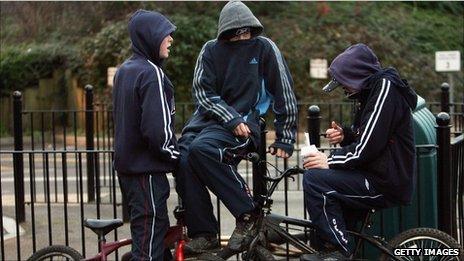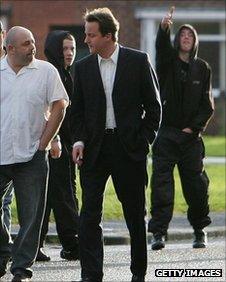Gangs in the UK: How big a problem are they?
- Published
- comments

Gangs are back on the agenda with the government's star American adviser arriving for a tour of Britain's inner cities and an international conference. But just how bad is the problem in the UK?
Some people think of "gangs" in terms of a murky underworld, populated by gangland bosses, family-run crime syndicates and mafias who specialise in the trafficking of people and drugs and other forms of high-level organised crime.
But for many Britons, a "gang" means a group of teenagers involved in petty crime, or graduating to selling drugs, stealing phones and even stabbing other young people from rival postcodes.
Gang has become a catch-all word.
In the wake of the recent riots in England, Prime Minister David Cameron promised to wage an "all out war" against gangs.
The riots prompted tough talking from the authorities and a great deal of introspection by the media and the general public about the state of British society.
The government reacted. Culprits were fast-tracked through the courts, a taskforce was set up and Bill Bratton, the former New York and Los Angeles police chief, was appointed as an adviser.
Bratton is back in Britain this week and is due to attend an international gangs conference organised by the Home Office on Thursday.
A major obstacle standing in the way of tackling gangs is an extraordinary lack of information.
The Home Office has no figures on the number of gangs, or indeed the level of gang-related crime, in Britain. There are official statistics on murder rates and the number of people admitted to hospital with knife wounds, but any gang element does not have to be recorded.
There are other reasons why reliable data is thin on the ground. A significant proportion of gang-related crime and violence is never reported and young criminals do not identify themselves as gang members when they appear in court.
The Home Office cannot even provide a definition of what a gang is. And this lack of an agreed definition is another reason why collecting data is so difficult.
Where does a gang begin and a group of mates dressed in sportswear end?
John Heale, author of One Blood, a study of British street gangs, defines a gang as such: "It's a group of about 10 or more individuals who have a name and who claim an allegiance to a geographic area but the reality is that it's a lot more messy."
He says five years ago, youths may have merely associated themselves with being members of a group or representing their estate but the idea of a gang has been amplified in young people's minds and those of the public.
"Every group is perceived to be a gang when in fact they are just kids hanging around street corners because they have nothing to do," says Heale.
Although the available data is patchy, it can be used alongside localised studies, academic research and anecdotal evidence to provide some insight into the extent and make-up of Britain's gangs.
One study for the Home Office found that up to 6% of 10-19-year-olds belonged to a gang, external in England and Wales.
In 2008 Strathclyde Police estimated there were 170 gangs in Glasgow, external, with 3,500 gang members aged from 11 to 23. The previous year, the Metropolitan Police said there were 171 gangs in London. , external
Gang expert Prof John Pitts estimates some 600 to 700 young people, external are part of gangs in the London borough of Waltham Forest alone.
At least half of the 27 murders of teenagers in London in 2007 were gang-related, according to the Metropolitan Police. Officers in Liverpool and Manchester have said in the past that 60% of shootings are linked to gangs.
The majority of Britons will have little or no direct experience of gangs but they are still frightened and fascinated by them in equal measure.
Generally, the risk of becoming a crime victim in Britain today is at a 30-year low. There has been a long-term downward trend in crime, including violent offences, since the mid-1990s.
Heale says the high levels of crime are happening within certain areas of our cities.
"By and large they are doing it to one another. The wider public is insulated from it until the riots this year."
There are periodic outbreaks of alarm over gangs. The last large-scale wave of concern came in 2007 with several high-profile murders, including that of 11-year-old Rhys Jones who was shot in the neck as he walked home from football practice in Liverpool.

The infamous "hug a hoodie" picture: David Cameron on a tour of a Manchester estate in 2007
This summer's riots in several English cities have put gangs firmly back in the headlines and on the political agenda.
But is the gang problem getting worse?
Ch Supt Nick Ephgrave, who works in the London borough of Lambeth, says gangs are not an "epidemic". He describes them as a "stubborn" problem that shows no sign of going away.
He says there are four or five groups of young people who define themselves by their postcode and will only move to different areas with the protection of their group. Violence boils up quickly from small issues of disrespect and soon becomes a cycle that will continue for several years.
In a speech on Wednesday night, Bratton said the gang problem in the UK was in its "gestation" period and could be stopped before it takes a "multi-generational hold".
"It's easier to stop because you are not dealing with a multi-generational problem like we had in the United States where we had grandfathers and grandsons in the same gang."
When Bratton was appointed some senior police figures attacked the decision, saying that cities like Los Angeles, which has 400 gangs, had little to teach the UK.
It is true that Britain has a different kind of problem to many other countries where gangs are more about organised crime and less about postcode loyalty.
In Mexico, the situation is as much a drug war between the state and drug cartels, rather than street gangs. Hardly a day goes by without another gruesome killing, and 40,000 people have died in the violence over the past five years.

Rightly or wrongly, this summer's riots have been linked to gangs
In the US there are 28,100 gangs and 731,000 gang members, external, according to the latest reports from the National Gang Center.
But Ephgrave says there are similarities between the UK and the US.
"The culture accompanying these groups is transatlantic. The clothing and music, the attitude to life and the words that are used come from America."
In its 2009 report into street gangs in Britain, the Centre for Social Justice think tank reported that gang violence had increased over the past decade.
It also found the nature and composition of the gang has shifted - members are getting younger, geographical territory is transcending drug territory and violence is increasingly chaotic.
Executive director Gavin Poole says it is clear that Britain faces a "serious problem", citing extreme cases of young girls being subjected to "appalling gang initiation ceremonies" and boys taking part in violent attacks to prove themselves.
Of course, the UK has a long history of gangs, from the Scuttlers in Manchester in Victorian times to the Teddy Boy gangs of the 1950s.
And Gwenton Sloley, a former gang member who now works with young people in the London borough of Hackney, says they are not going anywhere.
"Gangs have been around for centuries, they're a part of youth culture. You're not going to eradicate them."